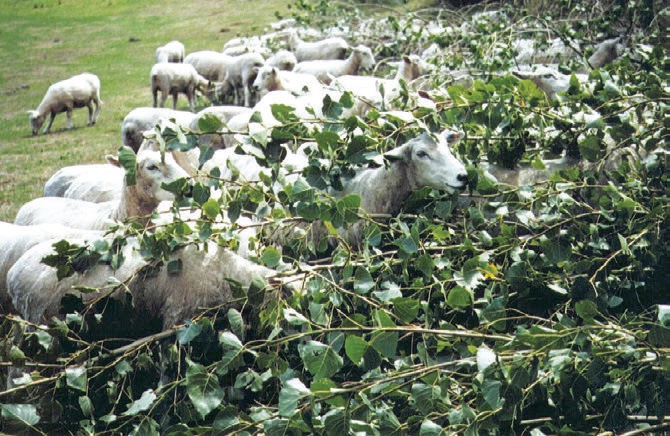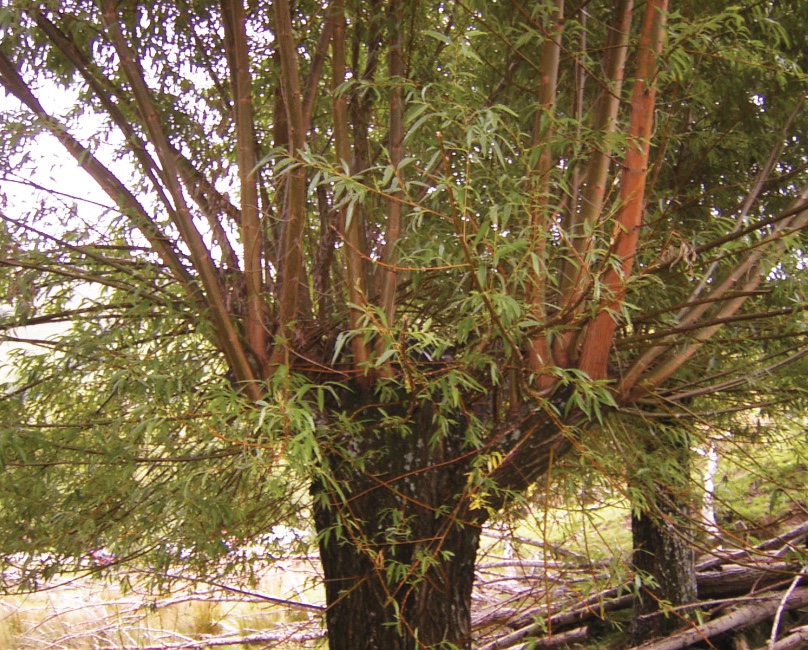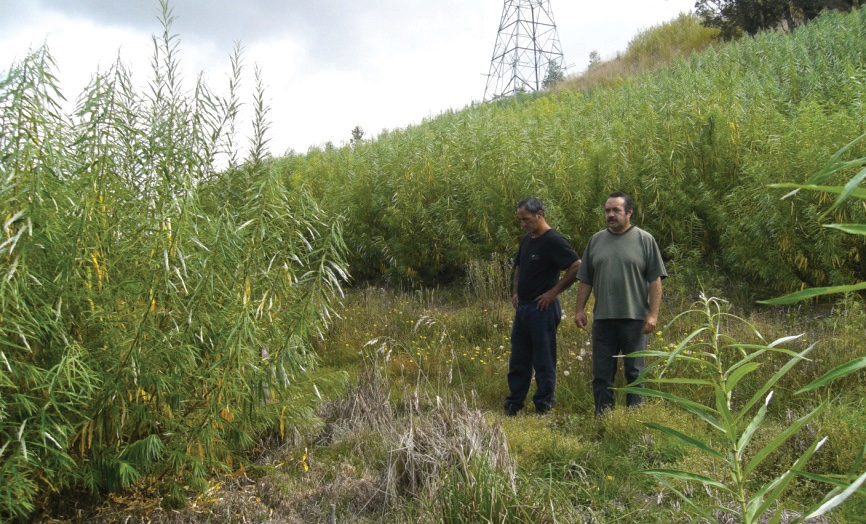Willows and poplars for drought mitigation
Trevor Jones and Ian McIvor, New Zealand Tree Grower November 2013.
This article, on using willow and poplar for animal feed in a drought, complements the article in the August issue of Tree Grower. The subject is not new but the information on feed quality is a useful addition to what you might already know.
Planting palatable trees for summer fodder should form part of a farm drought resilience plan. Often in a drought the only sight of green on parched farms are the trees, particularly poplars and willows. Some farmers are using this as a feed source for livestock, but many do not because of the effort and debris associated with its use.
Poplars and willows perform a soil conservation and water quality improvement role, and they are also valuable shade and shelter trees. The wise placement of trees on farms can provide a feed buffer in times of drought. Mature trees are capable of sustaining pollarding for fodder in cycles of three to four years.
Drought pasture is high in fibre and low in nitrogen and organic matter digestibility. Poplar and willow fodder is an ideal supplement as it provides sources of degradable nitrogen and soluble carbohydrate to stimulate microbial protein synthesis, as well as un-degradable dietary protein to meet the protein requirements of livestock.
Feed quality
The feed value of poplar and willows leaves is 60 to 70 per cent dry matter digestibility, about the same as lucerne hay. The crude protein level of 12 to 18 per cent and metabolisable energy is well above that required for livestock maintenance. The leaves and bark contain polyphenol compounds called condensed tannins, and phenolic glycosides such as aspirin, and these have health benefits for stock.

The condensed tannins are generally higher in concentration in willows, but differences occur between cultivars as shown in the table. Osier willows have higher concentrations of condensed tannins and lignin, compared with tree willows, which can lead to lower animal acceptability. Trials with sheep and goats have shown a 22 per cent lower voluntary intake of digestible dry matter for osier willows compared with tree willows.
Sheep show a preference for different poplar clones, but cattle do not appear to be selective. Feeding trials at Massey University have shown sheep will eat twice the quantity of leaves of the poplar clones Argyle and Kawa, compared with Eridano. This could be due to differences in the bitterness of the leaves.
Willow leaves are also high in zinc and magnesium, which are important animal health minerals. However, sodium levels can be low in willow leaves, and if little or no pasture is on offer, a salt block should be provided.
Nutritive value of forage from willow and poplar
| Cultivar | Leaf Per cent | Protein Per cent | Dry matter digestibility Per cent | Metabolisable energy Megajoules per kilogram | Condensed tannins Per cent |
|---|---|---|---|---|---|
| Willow | |||||
| Matsudana | 66 | 15.4 | 67 | 10.2 | 1.8 |
| Moutere | 68 | 15.5 | 70 | 10.5 | 4.0 |
| Tangoio | 56 | 11.7 | 58 | 8.7 | 4.2 |
| Poplar | |||||
| Argyle | 55 | 15.2 | 65 | 9.6 | 1.1 |
| Tasman | 60 | 12.8 | 69 | 10.0 | 2.4 |
| Toa | 67 | 13.4 | 61 | 8.9 | 0.6 |
| Veronese | 66 | 17.9 | 70 | 10.4 | 1.0 |
The bark good to eat
Poplar and willow bark also has good nutritive value. Cattle will eat branches of up to 10 millimetres in diameter and sheep up to seven millimetres, and both cattle and sheep will strip the bark off and eat it. Although the bark is lower in protein than the leaves, the protein content is sufficient to suggest that livestock eat the bark for its feed value.
Nutritive content of bark from trees of different ages
| Cultivar | Age years | Protein Per cent | Dry matter digestibility Per cent | Metabolisable energy Megajoules per kilogram | Condensed tannins Per cent |
|---|---|---|---|---|---|
| Willow | |||||
| Tangoio | 5 | 5.2 | 66 | 10.2 | 9.2 |
| Tangoio | 10 | 4.4 | 60 | 9.1 | 7.1 |
| Poplar | |||||
| Veronese | 5 | 3.3 | 58 | 9.2 | 2.2 |
| Veronese | 10 | 3.1 | 56 | 8.8 | 2.2 |
Benefits
Supplements of poplar and willow tree trimmings fed to ewes during periods of drought have been shown in Massey University studies to reduce live weight loss and increase reproductive rates. Feeding 1.3 kilograms of fresh willow trimmings per ewe per day from January to April reduced the live weight loss from 103 to 86 grams a day. It also increased the reproductive rate by 20 lambs for every 100 ewes mated, relative to ewes mated on drought pasture.
The cutting of tree trimmings, such as the pollarding of trees, is labour intensive. An alternative is the use of willow browse blocks, which have shown similar benefits. Mixed age ewes grazing willow browse blocks during a drought were shown to reduce live weight loss from 101 to 40 grams a day. The grazing also increased the reproductive rate, again by 20 lambs per 100 ewes.
The grazing of willow browse blocks can also show similar benefits during non-drought years. Hogget ewes grazed on willow browse blocks have shown increases in reproductive rates of 17 lambs per 100 hoggets mated, compared to grazing conventional ryegrass and white clover pastures.
Rust resistance cultivars vital
The increases in reproductive rates have been attributed to the condensed tannins in the leaves and bark of poplar and willow. Condensed tannins increase the amount of protein absorbed by the ewes by reducing the solubility and degradation of protein in the rumen and increasing the absorption of protein from the small intestine.
The increases in reproductive rates were not observed when the pasture was contaminated with fungi which produce oestrogenic mycotoxins or when rust- infected poplar leaves were used as supplementary feed. Therefore it is important to use rust-resistant cultivars of poplar and willow. Feeding willow supplements has also been found to reduce the number of some economically important internal parasites, although drenches are still required, and to reduce dag formation which should help in the control of fly strike.
Pollarding the trees
Poplar and willow trees can provide forage yields of 50 kilograms of edible dry matter per tree on trees of 30 centimetres diameter at breast height when they have been pollarded. Pollarding is cutting the branches of a tree to a stump at above cattle grazing height. The branches are cut to leave 10 to 20 centimetres, so the new shoots from the branch stumps are more spread out and better able to cope with wind.

Pollarded trees will re-grow bushy with plenty of stems for feeding but out of stock reach. These trees will still act as a ‘water pump’ helping to prevent erosion on unstable hill slopes. Soil conservation trees intended for pollarding should be planted six to 10 metres apart, and not pollarded for at least five years. Then they can be harvested on a three to four-year harvesting cycle.
The yield of edible forage leaves and stems from widely spaced trees of poplar and willow increases with tree age. At five years you should get two to three kilograms of dry matter per tree and at 10 years there should be 18 to 22 kilograms of dry matter per tree.
Willow browse blocks
Densely planted blocks of willows can produce up to seven tonnes of edible dry matter per hectare per year on five-year-old stools planted at 16,000 stems a hectare, and be grazed by livestock two or three times a year. Pasture production in the browse block is in addition to this.

Browse blocks are managed by cutting them back down to 15 to 20 centimetres above ground level after seasonal browsing to allow re-growth for the next summer. The best places to establish them are in swampy areas unsuited for good pasture growth. They will use the nutrients that run into the area, dry it out, and raise the productivity of the pasture as they provide tree fodder.
Forage yield and dimensions of Tangoio willow and Veronese poplar
| Cultivar | Age years | Forage as edible dry matter Kilograms per tree | Diameter at breast height centimetres | Canopy width metres | Canopy length metres |
|---|---|---|---|---|---|
| Willow | |||||
| Tangoio | 5 | 3 | 9 | 2.3 | 3.7 |
| Tangoio | 7 | 10 | 14 | 3.4 | 7.0 |
| Tangoio | 10 | 22 | 20 | 6.3 | 8.3 |
| Poplar | |||||
| Veronese | 5 | 2 | 7 | 2.2 | 3.0 |
| Veronese | 7 | 8 | 14 | 3.0 | 6.9 |
| Veronese | 10 | 18 | 21 | 4.2 | 12.7 |
Planting and managing
Willow browse blocks can be established in autumn and winter by blanket spraying the pasture with a non-residual herbicide in May, then ripping and planting in June with cuttings of 60 centimetres long to a depth of half this length. Larger cuttings of 25 to 35 millimetre diameter have better survival and growth. Planted tree stockings of 6,000 stems a hectare are commonly used.
The blocks can be managed in the following way −
- Close the area from livestock to allow the trees to grow and the herbage to regenerate. The blocks can be grazed with sheep in the first growing season from January. In the second growing season young cattle can be put into the browse block in late summer.
- When the trees are well established, graze the blocks in December, February and March, allowing about eight weeks between grazing, with each block grazed for seven to 10 days on this rotation.
- Graze hard with ewes in mid-May to eat down the tree stems, although mechanical topping may be needed to reduce the tree height.
- Graze lightly over winter and early spring, but close in September and early October to protect the developing leaf buds.
One of the challenges encountered with browse blocks is control of the grasses growing in them, particularly in spring. A system of three grazings at eight-week intervals during the growing season has been devised to keep the herbage under control and of reasonable nutritive value while allowing the trees to regenerate.
The use of pollarded trees and browse blocks should be viewed as long-term measures for the mitigation of drought as the fodder productivity of the trees increases incrementally over several years. They can improve the reliability of the feed supply on farms and have the added benefits of providing soil conservation on slopes, shade and shelter, increased reproductive rates, and improved health of livestock on farms.
Trevor Jones is a researcher and Ian McIvor is a senior scientist at Plant & Food Research based in Palmerston North.

 Farm Forestry New Zealand
Farm Forestry New Zealand